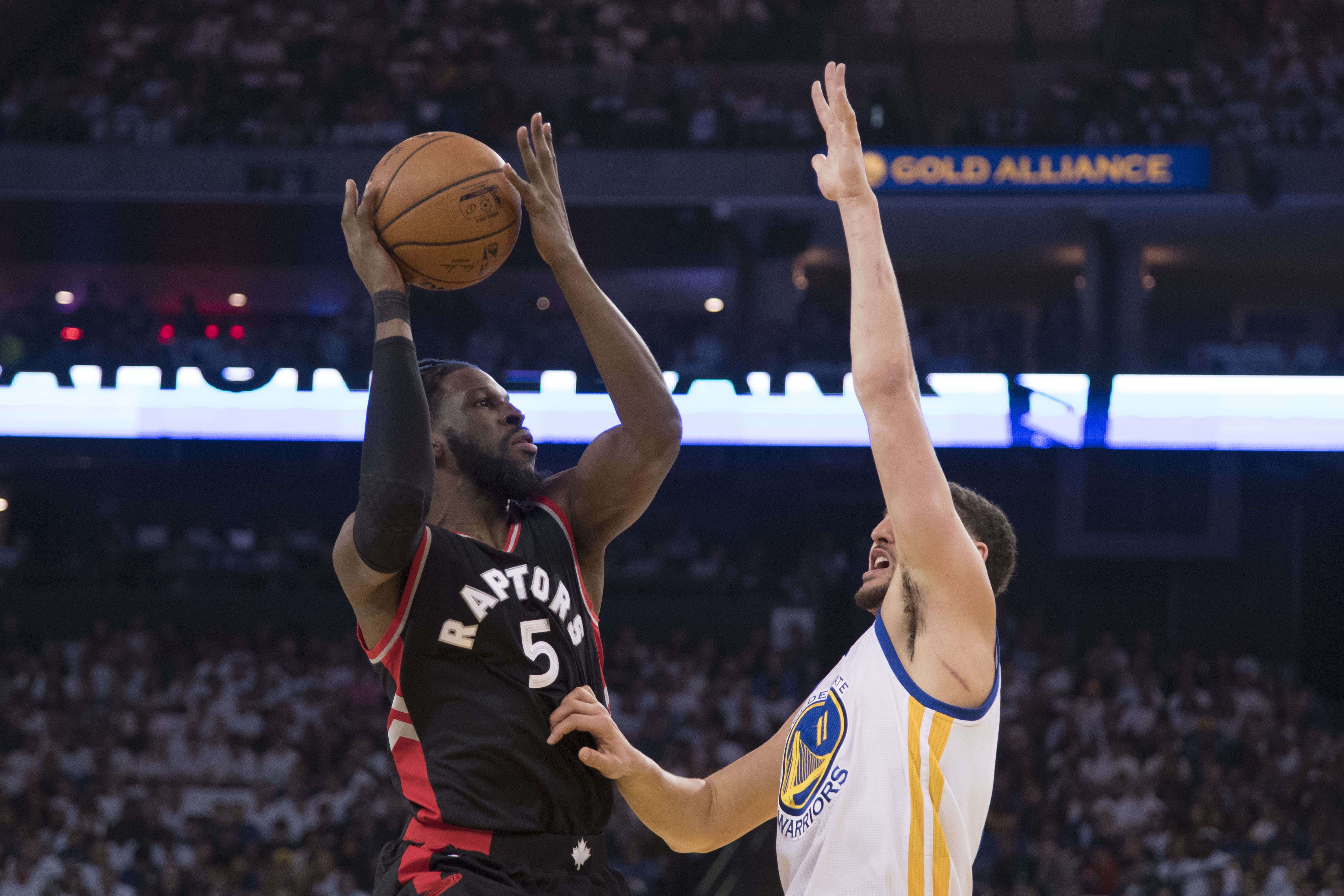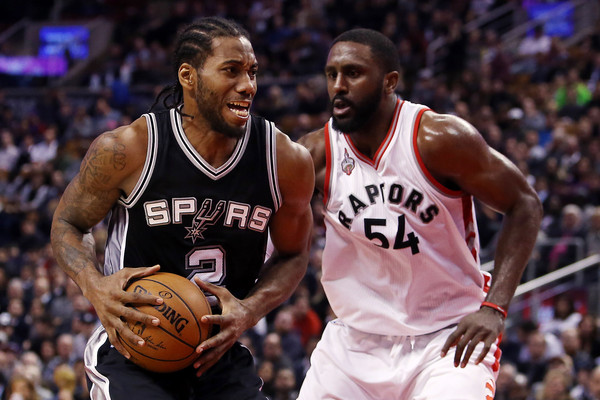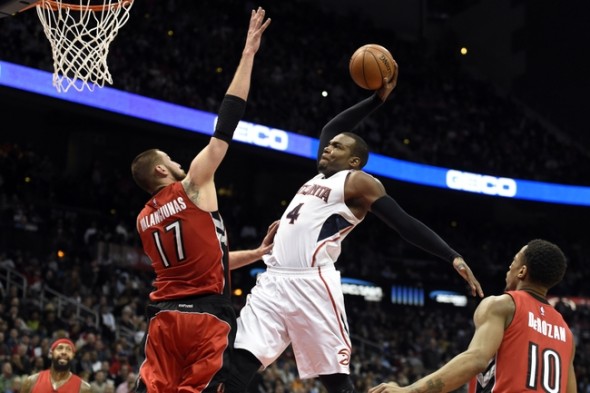“Why isn’t Norman Powell playing more?”
That’s one of the most common questions I receive on Twitter, in the comments, in the DMs, and so on. It’s a reasonable one considering Powell has mostly played well when called upon, filling a variety of different roles as needed. The cluttered path to playing time is something most seem to understand, at least at the guard positions. Kyle Lowry and DeMar DeRozan play heavy minutes, Cory Joseph is entrenched as the backup point guard, often playing alongside Lowry, and Terrence Ross is having the best season of his career, himself making a case for more playing time. The Raptors have am embarrassment of depth at the guard positions, and Powell’s the odd man out until he’s not.
As the season’s wore on, though, the question posed to me has shifted some. It’s no longer a matter of how to get Powell minutes at his natural guard spot, but why the Raptors haven’t begun downsizing on the wing and playing three of the players from that five-man guard rotation.
The reason behind that shift seems to be not only continued faith in Powell, but a growing lack of confidence in DeMarre Carroll.
Carroll is healthy enough now to have his back-to-back restriction lifted, which is a positive. Whatever the specifics of the Raptors’ long-term plan for their big 2015 investment, Carroll’s gone from being at something less than 100 percent in training camp to able to handle full games to now being able to handle back-to-backs. From a strictly medical perspective, those steps are important and encouraging. All signs point to the health and strength in his knee improving, an important consideration for his long-term outlook and his potential status for the postseason.
As healthy as the knee might be, though, Carroll is not playing particularly well. A slow start gave way to a really encouraging 15-game stretch across late November and early December, but Carroll’s play has regressed to its preseason form of late. Even when things were going well and Carroll was knocking down open threes and working as a dangerous cutter off the ball, his trademark defense wasn’t at its customary levels. Now that the offense has slowed – he’s averaging 5.6 points on 31-percent shooting over his last five games – the defensive shortcomings are becoming more pronounced, or at least easier to jump on.
To be clear, Carroll hasn’t been consistently abhorrent, or anything – he had a great second half against Golden State, for example, and is still hitting 36.2 percent of his threes on the season – but he’s struggling, with Sunday’s game against the Lakers standing out as one of his worst on the year. His net rating is better than only Joseph and Pascal Siakam among regulars, his defensive rating is better than only Joseph and Jonas Valanciunas, and the question has been raised as to whether the struggles of that Siakam-Valanciunas frontcourt extend to the three-man unit (they’ve been outscored by 3.6 points per-100 possessions in 346 minutes together, bleeding 110.9 PPC on the defensive end). From a more descriptive perspective, his man-to-man defense isn’t exactly passing the eye test, either, with Carroll making curious decisions in help scenarios (often borne of trying to do the right thing, but still), getting back-cut more than he’s used to, or simply getting beat by non-elite scorers. This is not the Carroll that the Raptors were hoping for, and the team’s league-average defense needs him to be better.
That some look at his performance, compare it to Powell’s, and want to shift the rotation in response makes sense. NBA rotations are supposed to be a meritocracy for the most part, and while playing Powell as the extra wing creates some potential weaknesses – the Raptors would be small, they’re already struggling to rebound the ball, they could be susceptible to larger power-threes – he’s been better than Carroll for stretches this year. It also wouldn’t need to be a pronounced shift, just a few minutes here and there, with Carroll still available in larger chunks for the tougher physical matchups, and likely playing some power forward as the downsizing gets more aggressive. Were the Raptors trying to maximize every minute of play right now, Powell (or even Ross) would be playing a bit more, and Carroll would be getting something less than his 25.2 minutes per-game.
The tricky thing when it comes to Carroll, though, is that the Raptors aren’t necessarily trying to maximize every minute of play right now. Carroll was brought in for a lot of reasons, but he’ll be measured almost solely by his impact in the postseason. That’s why it wasn’t all that frustrating to see him brought along slowly to start the year, nor would it be that big a deal if the rest pattern continued to be somewhat aggressive to keep him fresh for April. The Raptors know they’re good without Carroll, and they know how they can play without him. They don’t yet have a great grasp of what they are with Carroll, particularly Carroll when he’s functioning at something close to his 2014-15, like he was briefly in late November.
In talking with a few of the Atlanta Hawks when they were in town in December, they admitted that playing with Carroll, at least on the offensive end, takes some getting used to. He commands exactly zero plays run for him, and the learning curve for new teammates and a new system can be methodical. Carroll’s offense comes primarily from recognizing the attention being paid to the team’s stars and exploiting the seams, and figuring out the right balance and timing is a work in progress. The Raptors need to get Carroll reps with the team’s stars, in other words, because Carroll’s offensive game exists in nuance. Defensively, some of Carroll’s struggles have come from trying to do too much to help his teammates out, and that, too, requires some additional repetition within the team’s system and alongside its core pieces. He’s also just played very little basketball over the last 19 months or so, and a player who relies on his intelligence and anticipation so much probably needs some leash to find his groove. The one-on-one defense is the most concerning element and may not just come back, but writing Carroll off is hardly a workable solution.
It can be frustrating, watching Carroll struggle while other lineup iterations may produce better results in the short-term. But the Raptors need to continue to find out what they have with Carroll and what he can be for them in the postseason, and they can afford to give him plenty of leash with an eye toward learning about themselves. The 82-game slough is about winning, but when you’re established as a quality team, it’s also about finding out how you can be your best in April and May, and Carroll is, in theory, a big part of a game-plan for the Cavaliers, or even the Bucks, Bulls, Pacers, or Knicks in earlier rounds.
Head coach Dwane Casey has shown he’ll go to Powell later in games when Carroll doesn’t have it and the game is on the line, and in general, Casey’s proven far more flexible and experimental than he gets credit for. He showed that in the postseason last year, too, and it stands to reason that when the leverage is much higher, Casey will roll with what – and who – is working best. Until then, playing Carroll heavy minutes despite his struggles doesn’t speak to a lack of flexibility, it speaks to the team taking the long-view about a player they might not always be at their best with now, but who they need at his best to reach their ultimate ceiling later. Maybe he doesn’t get there, but it’s worth being patient now, when it matters less, to give him the chance.



